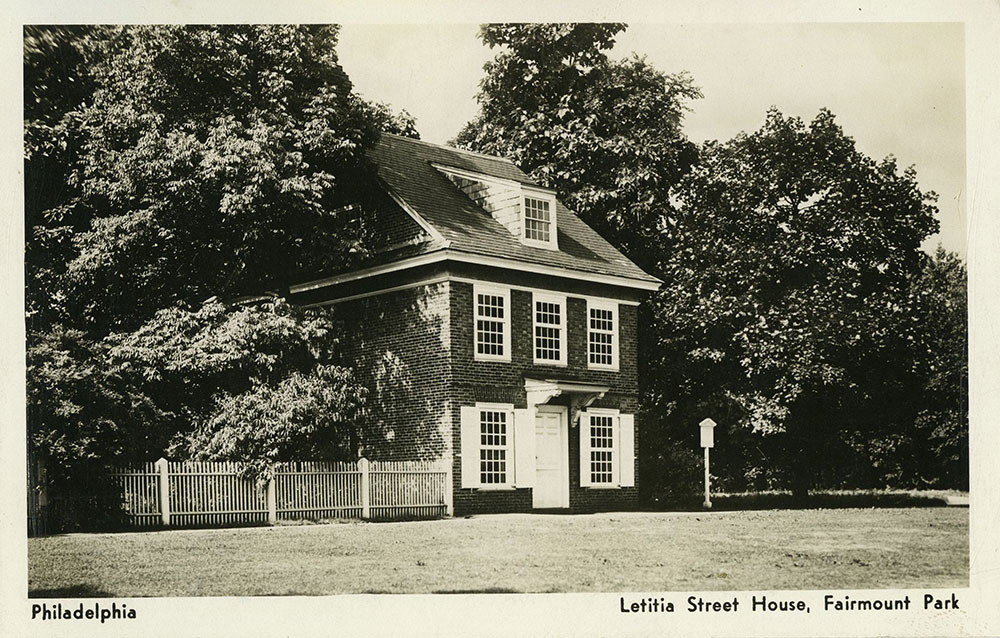Related Posts
- Buy Tickets for The Constitutional Walking Tour of Philadelphia – See 20+ Sites on a Primary Overview of Independence Park, including the Liberty Bell and Independence Hall
- Belmont Mansion and the Underground Railroad
- Lemon Hill Mansion
- Mount Pleasant Mansion

Until the 20th Century, this small unassuming brick townhouse on Letitia Street (now relocated to Girard Avenue) was assumed to have been built in anticipation for the first arrival of William Penn in the New World. Instead, the story of the Letitia Street House is indicative of the power of rumor, myth and the urge to preserve a historical legacy.
This legend seems to have gained popularity in the early 19th Century when Philadelphia historian John Fanning Watson examined records from Gabriel Thomas, one of the first Englishmen in Philadelphia.
Before Penn’s arrival in 1682, Thomas described a cellar being dug for the use of the new Governor. Thus, many had theorized on scant additional evidence that the cellar which Thomas was describing was a similar cellar beneath Letitia Street House. When Watson published his Annals of Philadelphia in 1830, the idea spread so far that in 1846, when Penn’s great-grandson Granville John Penn, visited Philadelphia as a guest of honor, he was treated to a reception at Letitia Street House.
This rumor continued to grow until it was so widely accepted that during the 1876 Centennial Exposition, when millions had descended upon the City of Philadelphia to celebrate the America's founding 100 years previously, a guidebook for the event written by Thomas Westcott claimed that Letitia Street House was the “oldest house in Philadelphia” and even was “the first house which was built in the city”.
Eventually, the house’s legacy prompted the City of Philadelphia to purchase the early Georgian abode in 1883, relocating it from the Delaware River waterfront to Fairmount Park to be restored as a house museum. However, during this process, new details began to emerge surrounding the estate. In the 1930s, Fiske Kimball, longtime director of the Philadelphia Museum of Art, managed the home’s restoration and grew increasingly skeptical about its ties to William Penn.
We now know that the home was constructed not in 1682, but in 1713 by Thomas Chaulkney, a Philadelphia merchant and Quaker preacher. The land had been previously owned by William Penn’s oldest surviving daughter from his first marriage, Letitia Penn Aubrey, for whom the street is named after. However, the house was never intended to be the residence of any member of the Penn family, and the naming of Letitia Street was tied only to the fact that Penn had deeded the land to her, and she had that very land divided into lots while she married in England.
Every other building in Philadelphia associated with William Penn had been demolished by the late 19th Century, including the Slate Roof House where he stayed on his second visit, as well as his nearby country estate.
Perhaps the Letitia Street House was a yearning desire to consecrate Penn’s legacy with a surviving establishment. Despite this shattering revelation, Kimball maintained the property to exhibit Queen Anne style furniture until the house museum’s closing in 1965. The building was then used as office space for the Philadelphia Zoo until they declined to renew its charter in 2008. It has since remained vacant, but while its past is now transparent, its future remains uncertain.
Its conservators today are optimistic. They hope that it will be repurposed as an open area for the community to pursue outdoor activities, such as gardening. While the Letitia Street House may not have been the residence of Philadelphia’s founder, it provides a cautionary tale about the power of a story.



